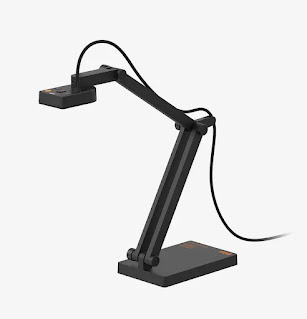Blog Post #3: The Educational Potential of Document Cameras
 |
| This image shows a common document camera model from IPEVO Innovating Communications. Image retrieved from https://us.ipevo.com/products/ipevo-v4k-pro-120-store |
Document cameras, also referred to as visual presenters or visualizers, are devices that can capture an image or a video and display it on a larger screen. The predecessor to document cameras was the overhead projector which would project an image onto a screen in real-time. However, this modernization of the overhead projector allows for the images and videos captured on a document camera to also be saved and shared digitally. Document cameras are used as a tool in the classroom to assist teachers in presenting and sharing information in a way that is collaborative with the students and makes resources more visually accessible to the entire classroom.
Their use in the k-12 classroom environment can be better understood by looking at the document camera through the lens of the R.A.T. Model.
The R.A.T. model, developed by Dr. Joan E. Hughes, is described as, "...an assessment framework for understanding technology's role in teaching, learning, and curricular practices..." and allows for the objective assessment of technology tools (Tech Edges, 2016). This model will assist in better understanding the benefits of using a document camera in a k-12 environment.
Replacement
The first part of the R.A.T. model is replacement which outlines how a technology tool is used in a way to replace some aspect of a teaching practice or tool, without changing or improving anything about it. The document camera can act as a replacement for the previously used overhead projector. It preforms the same function of projecting work in real-time from a small scale to a larger scale to make the work visible to an entire classroom. Although the document camera can do more than the overhead projector, if those functions are not utilized, it simply serves to be a replacement.
Amplification
The next section of the model is amplification. This shows how a tool can used to support instructional practices to make them more effective and efficient. While the instructional tasks stay largely unchanged, the tech tool can be used as an enhancement of them. The document camera can amplify instruction through making the presentation of information more collaborative than it would be with a typical slideshow presentation. Students are able to engage with the content alongside the teacher which provides an opportunity to have more meaningful class discussions. It also allows the teacher to show materials to the class at one time in a way that is visible to all students. For example, a read aloud of a book, especially a children's book, can be enhanced by placing the book under the document camera while reading to give students a clear visual of the text.
Transformation
The final section of the R.A.T. model is transformation, which outlines how a tech tool can alter and reinvent instructional practices, tasks, and learning experiences. It can also show how a tool can be used to make learning more accessible for students. One of the major ways that a document camera can transform the way students learn is through the ability to support a flipped classroom. With flipped classrooms, students work at their own pace to interact with instructional content. Document cameras would allow teachers to record instructional videos for students to watch outside of class time which would open up the time in class for discussions, tactile and kinesthetic learning experiences, and problem-solving. It can also make learning more accessible to all students by recording and sharing classroom lessons for students that are homebound for a period of time.
Teacher and School Librarian Resources for Using a Document Camera:
- Edutopia Article
- Offers insight into the ways that a document camera can be used to enhance the learning experience for students in the classroom setting.
- HuddleCamHD Article
- Gives advice on how to best use a document camera to support learning at early childhood, middle, and high school levels. It also provides a video discussing how the document camera can be used in a online education setting.
References
Cogency. (2020, November 25). Using a document camera in the classroom. HuddleCamHD. https://huddlecamhd.com/using-a-document-camera-in-the-classroom/
Ipevo V4K pro 120 4K USB document camera. IPEVO US. (n.d.). https://us.ipevo.com/products/ipevo-v4k-pro-120-store
Rankin, E. (2024, October 29). In praise of the humble document camera. Edutopia. https://www.edutopia.org/article/effective-use-document-camera/
Tech Edges. (2016, June 24). R.A.T. model. Dr. Joan E. Hughes | TechEdges | Technology Integration Research. https://web.archive.org/web/20190612101737/https://techedges.org/r-a-t-model/



Hi Hannah! Thank you so much for sharing information with us about the document camera! I am a bit embarrassed to admit that I had one in my classroom, but I never used it before I left teaching. It seemed like a great concept, especially as I depended heavily on the overhead projector in my earlier years of teaching Spanish. I just never made the time to learn how to use the document camera. Your post and linked resources, however, helped me to see that it is much more than a modern overhead projector. I had no idea that it could record lessons! That is awesome! I also appreciate how you explained the R.A.T. model and gave examples of replacement, amplification, and transformation using this device!
ReplyDeleteHannah, I apologize. I completely forgot to let you know in my original comment that my name is Cameron Bongiorno.
Delete